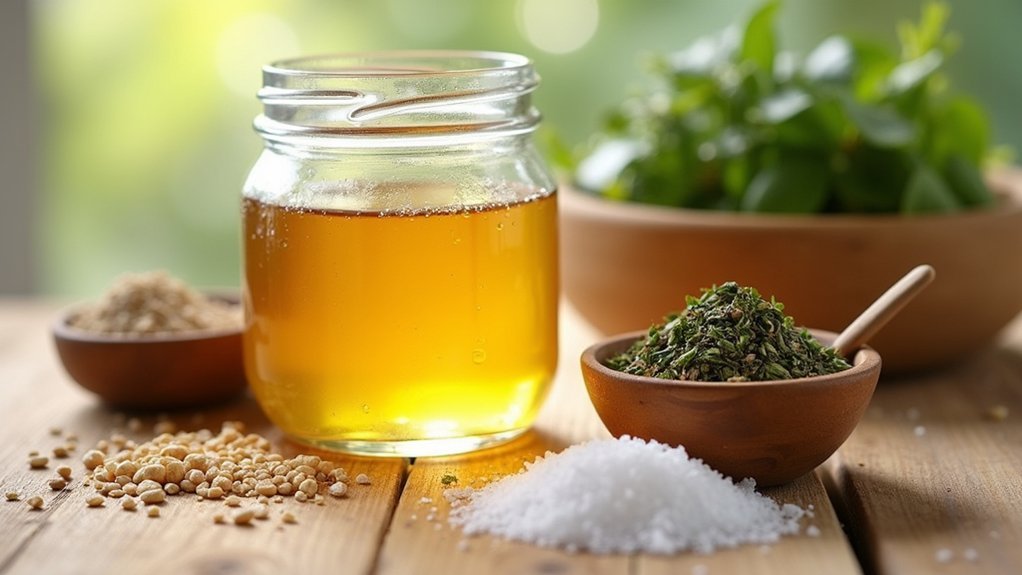To create effective vinegar ant barriers, mix white vinegar and water in a 1:1 ratio (or 3:1 for stubborn infestations) in a spray bottle. Apply daily around entry points like doorways, windowsills, and foundation cracks to disrupt pheromone trails. Focus on kitchens, bathrooms, and plumbing areas. For enhanced protection, add 10 drops of peppermint essential oil to your solution. Maintain barriers more frequently during summer and seal cracks before winter to keep your home ant-free year-round.
Understanding Why Vinegar Works Against Ants
Five key mechanisms make vinegar an effective ant deterrent. When you apply vinegar to surfaces, its high acidity disrupts pheromone trails that ants use to navigate and communicate. This confusion fundamentally blinds the colony’s coordinated movements, preventing them from following established paths to food sources.
Vinegar’s strong smell masks food odors that typically attract ants to your home. Additionally, undiluted vinegar acts as more than just a deterrent—it can kill ants on contact by corroding their exoskeletons. The acidic environment created by vinegar solutions damages ants’ protective outer layer, leading to deadly dehydration.
Regular application maintains a persistent barrier that ants won’t cross. This consistent treatment creates an inhospitable zone that discourages new colonies from establishing themselves in treated areas.
Essential Supplies for Creating Vinegar Barriers
To create effective vinegar ant barriers, you’ll need white vinegar, a spray bottle, and cotton balls as your basic supplies.
Choose a quality spray bottle with an adjustable nozzle that won’t leak when you’re applying the solution to baseboards and entry points.
For best results, mix equal parts white vinegar and water, though you can use undiluted vinegar on cotton balls for stronger barriers in severe problem areas.
MATERIALS NEEDED
Preparing an effective ant barrier requires just a handful of common household items. You’ll need white vinegar as your primary ingredient—its high acidity disrupts ant pheromone trails and deters their navigation. A spray bottle is essential for applying your vinegar mixture to entry points, trails, and nests.
| Essential Item | Purpose |
|---|---|
| White vinegar | Disrupts ant pheromone trails |
| Spray bottle | Applies solution to targeted areas |
| Measuring cups | Creates proper vinegar-water mixture |
Don’t forget cotton balls or rags to soak in undiluted vinegar for placement in high-activity areas. A funnel will help you transfer your mixture into the spray bottle without spills. With these simple supplies, you’re ready to create barriers that will effectively keep ants from invading your space.
SPRAY BOTTLE SELECTION
With your materials gathered, the right spray bottle becomes your next consideration.
Choose one made of HDPE or similar chemical-resistant material to prevent degradation from vinegar’s acidity.
Look for a bottle with 16-32 ounce capacity to minimize refills when treating larger areas. A clear measurement scale on the side guarantees accurate mixing of your vinegar solution for consistent results.
For effective application, select a bottle featuring an adjustable nozzle or fine mist setting. This allows you to precisely target ant entry points and create thorough barriers along baseboards and perimeters.
Don’t overlook ergonomics—a comfortable trigger mechanism reduces hand fatigue during extended use.
Your spray bottle is more than just a container; it’s the delivery system that determines how effectively your vinegar solution deters ants.
MIXING RATIO BASICS
The foundation of effective ant repellent begins with mastering the correct vinegar-to-water ratio.
For most indoor ant problems, a 1:1 mixture of white vinegar and water creates a reliable barrier that disrupts ant pheromone trails without overwhelming your space with a strong vinegar scent.
When dealing with persistent ant invasions or outdoor barriers, increase your vinegar solution to a more potent 3:1 ratio. This stronger concentration delivers enhanced repelling power against determined ant colonies.
To boost your mixture’s effectiveness, add 10 drops of essential oils like peppermint or tea tree per cup of vinegar solution. These natural additives amplify the repellent properties while providing a more pleasant aroma than vinegar alone.
Remember that consistency in your mixing ratio basics guarantees reliable results when creating barriers to repel ants.
The Perfect Vinegar Solution Ratio for Maximum Effectiveness
Finding the right concentration of vinegar to water creates the foundation for an effective ant barrier in your home. For standard ant control, mix a 1:1 vinegar solution—equal parts white vinegar and water—to disrupt pheromone trails that ants use for navigation.
When facing persistent infestations, increase the strength to a 3:1 ratio, applying this concentrated solution directly to ant hotspots. For enhanced effectiveness, add a few drops of essential oils like peppermint or tea tree to your mixture, which improves both performance and scent.
Apply your solution in the evening when ant activity peaks, and maintain a consistent schedule of reapplication every few days. This persistence prevents ants from re-establishing their pathways and guarantees your vinegar barrier remains effective long-term.
Strategic Placement of Vinegar Barriers Around Your Home
Effective ant control begins at strategic entry points where these persistent pests first infiltrate your home. Identify doorways, windows, and wall cracks as prime locations for applying vinegar solutions that disrupt ant trails and create protective barriers.
| Location | Application Method | Reapplication Frequency |
|---|---|---|
| Doorways & Windows | Spray 1:1 solution along frames | Daily, especially after cleaning |
| Foundation Edges | Apply 3:1 solution around perimeter | Every 2-3 days and after rain |
| Interior Cracks | Direct application to high-traffic entry points | Twice weekly |
For maximum protection, establish a consistent perimeter by spraying along your home’s foundation. Don’t forget less obvious entry points like utility pipes and cable lines. You’ll need to reapply more frequently in areas with heavy ant activity, ensuring your vinegar barriers remain effective deterrents.
Combining Vinegar With Essential Oils for Enhanced Protection
While vinegar alone creates an effective ant barrier, combining it with essential oils dramatically improves your defense against these persistent invaders.
Mix 1 cup of vinegar, 1 cup of water, and 10 drops of peppermint or tea tree oil for a powerful deterrent that disrupts ant communication systems.
This potent combination works in two ways: vinegar erases existing pheromone trails while essential oils confuse ants and prevent them from finding their way back to food sources.
Spray this solution around entry points and areas with high ant activity to establish stronger ant barriers.
For long-term prevention, apply your vinegar-essential oil mixture regularly.
You’ll not only repel current ant invasions but also mask food scents and clean surfaces, making your home less attractive to future scouts.
Maintaining Your Ant Barriers Through Different Seasons
Adjusting your vinegar barriers with the seasons guarantees year-round protection from ant invasions.
During summer, apply vinegar solutions daily around entry points, while fall requires more frequent applications as ants seek winter shelter indoors.
In winter, maintain a monthly cleaning routine with vinegar to eliminate residual pheromone trails, even when ant activity appears minimal.
Fall Preparation Techniques
As autumn leaves begin to fall, your ant barriers need special attention to combat the seasonal shift in ant behavior. Ants actively seek warmer indoor spaces during this time, making your home vulnerable to invasion.
Regularly inspect and reinforce your vinegar solutions around entry points, focusing on windows and doors where temperature differences are most noticeable.
- Create a protective zone by applying diluted vinegar around your home’s foundation, rejuvenating after rain or wind exposure.
- Clean outdoor living areas thoroughly with vinegar solutions to eliminate food residues that might attract foraging ants.
- Seal visible cracks and crevices with vinegar treatments, paying special attention to southern-facing walls where ants may congregate for warmth.
These proactive measures will prevent ants from invading your home when they’re desperately seeking shelter for the cooler months ahead.
Summer Vinegar Strategies
Summer heat brings a surge in ant activity, requiring vigilant maintenance of your vinegar barriers to protect your home.
Mix vinegar and water in a 1:1 ratio and apply weekly around all entry points to maintain effective coverage. For areas with heavy ant traffic, increase to a stronger 3:1 solution to thoroughly disrupt pheromone trails.
During summer months, regularly inspect for new cracks that develop from heat expansion and seal them with caulk to complement your ant barriers.
Remember to reapply your vinegar solution after rain or watering, as these can wash away your defenses.
Combine these barrier techniques with diligent cleaning of outdoor eating areas and kitchen surfaces to eliminate food sources that attract ants during peak summer activity.
Winter-Proofing Your Home
Winter brings new challenges for maintaining effective ant barriers as the pests shift tactics to find warmth and shelter in your home. Inspect and seal all cracks around windows and doors to prevent ants from finding entry points. Your vinegar spray needs more frequent application during colder months, as its effectiveness diminishes over time due to environmental factors.
- Clear away leaves and snow from your home’s perimeter to eliminate potential ant hiding spots.
- Guarantee proper drainage around your foundation to prevent standing water that attracts ants during winter thaws.
- Maintain regular cleaning of indoor surfaces with vinegar to disrupt pheromone trails.
Keep food properly stored and surfaces clean to eliminate attractants. Remember, winter doesn’t mean ants disappear—they simply become more determined to share your warm, comfortable space.
Troubleshooting Common Issues With Vinegar Barriers
Even when properly applied, vinegar barriers can sometimes fail to keep ants at bay, leaving you frustrated with their continued presence.
If you’re experiencing persistent ant problems, verify your vinegar solution is freshly mixed, as effectiveness decreases over time. Apply it consistently along all ant trails and potential entry points—incomplete coverage often leads to continued infestations.
Examine your barriers carefully for tiny cracks or gaps that provide alternative routes for these determined insects.
If ants still cross your defenses, try increasing the vinegar concentration or adding essential oils to enhance the repellent properties. Monitor results regularly and adjust your approach accordingly.
Sometimes combining vinegar barriers with other deterrents creates a more thorough defense system when a single method proves insufficient.
Protecting Specific Areas: Kitchen, Bathroom, and Entry Points
Different areas of your home require targeted vinegar barrier strategies to effectively keep ants at bay.
In the kitchen, spray your vinegar solution on countertops and around appliances to disrupt pheromone trails.
For bathrooms, apply vinegar under cabinets and around plumbing to eliminate moisture that attracts ants.
Don’t forget to fortify entry points by thoroughly treating doorways, windowsills, and gaps where ants infiltrate.
Enhance your defenses by adding essential oils to your mixture for stronger repellency.
- Wipe down kitchen surfaces daily with vinegar to remove food residue and ant trails
- Apply vinegar solution around bathroom sink drains where moisture accumulates
- Combine vinegar with peppermint essential oils at entry points for maximum effectiveness
Reapply your barriers regularly, especially after cleaning or rainfall, to maintain a continuous ant-deterrent perimeter.
Comparing White Vinegar vs. Apple Cider Vinegar Effectiveness
When choosing your ant-fighting arsenal, understanding the key differences between white vinegar and apple cider vinegar can dramatically improve your results.
White vinegar contains higher acidity levels (5-7%) compared to apple cider vinegar (4-6%), making it more effective at disrupting ant pheromone trails.
You’ll find white vinegar’s strong smell more repellent to ants than apple cider vinegar’s milder aroma, providing better immediate deterrence.
Unlike apple cider vinegar, which contains sugars that might leave attractive residue, white vinegar’s clear composition won’t inadvertently lure more pests to your home.
For ideal pest control methods, use undiluted white vinegar – it kills ants on contact more effectively and doesn’t leave the sticky residue that could attract other insects.
If you’re serious about ant prevention, white vinegar is your superior option.
Long-Term Strategies for Keeping Ants Away With Vinegar
While one-time applications of vinegar can temporarily deter ants, establishing a consistent maintenance routine proves vital for lasting protection against these persistent insects. Keeping ants at bay requires strategic and regular implementation of your vinegar solution.
- Create a weekly schedule for spraying vinegar solution (1:1 ratio) along baseboards, window sills, and entry points to maintain effective ant barriers year-round.
- Enhance your deterrent by adding 10-15 drops of peppermint or tea tree oil to your vinegar mixture, creating a more powerful barrier that ants actively avoid.
- Combine your vinegar routine with proper food storage and prompt cleanup of spills to eliminate attractants that might overcome your ant barriers.
This thorough approach guarantees your home remains protected from ant invasions while using natural, non-toxic methods.
Frequently Asked Questions
How Do You Make an Ant Barrier?
You’ll create an ant barrier by mixing equal parts white vinegar and water in a spray bottle. Apply it to entry points daily, disrupting pheromone trails. Add essential oils like peppermint for enhanced effectiveness.
How Do You Make Ant Repellent With Vinegar?
Mix equal parts white vinegar and water in a spray bottle. Add a few drops of peppermint or tea tree oil for extra strength. Spray directly on ant trails, entry points, and nests. Reapply regularly.
What Barrier Will Ants Not Cross?
Ants won’t cross barriers made from vinegar, diatomaceous earth, or essential oils like peppermint. You’ll find they’re repelled by strong smells that disrupt their pheromone trails and substances that damage their exoskeletons.
How Long Will Vinegar Keep Ants Away?
Vinegar will keep ants away for several hours to a few days. You’ll need to reapply it regularly as its scent fades. It’s more effective on non-porous surfaces and works best with daily application.
In Summary
You’ve now mastered the art of creating effective vinegar ant barriers! By combining the right vinegar solution, strategic placement, and consistent application, you’ll keep those persistent invaders at bay. Don’t forget to reapply after rain or cleaning, and consider complementing your vinegar barriers with essential oils for maximum effectiveness. With these techniques, you’re well-equipped to maintain an ant-free home naturally.





Leave a Reply